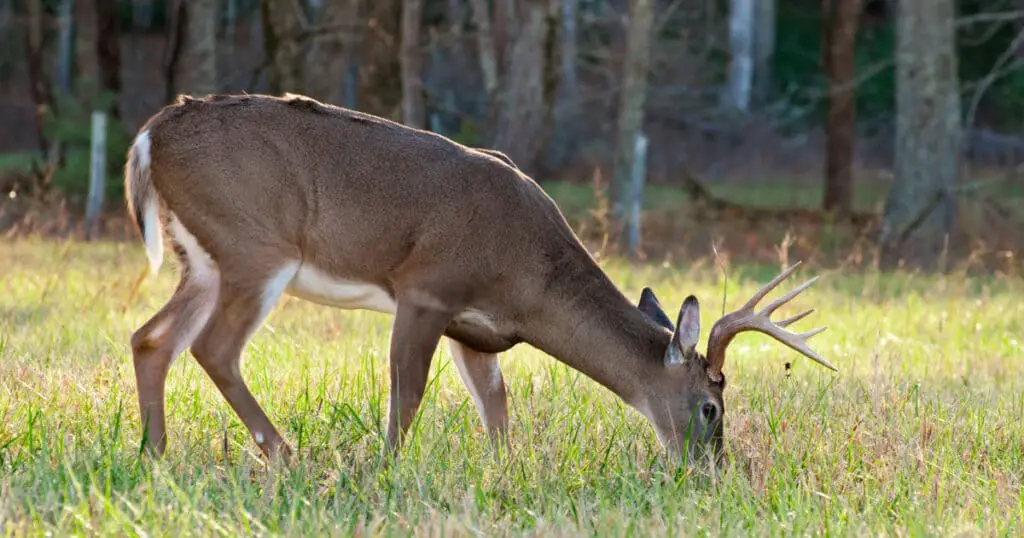If you’re a photographer or hunter on the lookout for white-tailed deer, one of the most important questions you’ve probably asked yourself is what does a white tailed deer eat? Understanding the diet of this animal will make tracking white-tailed deer much easier.
White Tailed Deer are a Challenge
One of the reasons why white tailed deer are so challenging to find and hunt is the fact that they’re so difficult to see. The first step you can take in finding white tailed deer is to understand their behaviors and diet.
They are herbivores, don’t eat meat, and instead, they munch on vegetation.
White tailed deer enjoy grass, leaves, fungi, lichens, mushrooms, alfalfa, twigs, nuts, and fruits.
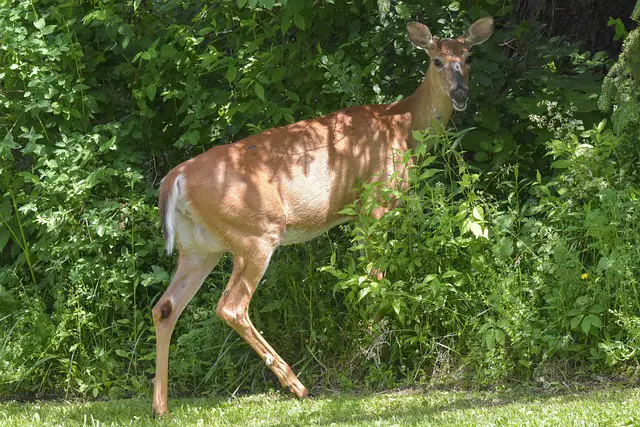
These animals generally do most of their eating in the low light, such as at dusk or dawn, or at night. This is because they find it easier to find their food under these conditions.
White Tailed Deer Avoid Mature Grass
Given that white tailed deer are herbivores, it might surprise you to learn that they prefer to stay away from mature grass. They tend to choose young vegetation and broad-leaf weeds instead. One reason for this is the fact that the deer’s upper jaws have only one cartilage, while a deer’s incisor teeth are found only on the lower jaw.
This means that it is challenging for white tailed deer to get ahold of hard shoots from the forest floor. They are able to chew on weeds, however, because of the molars on the upper and lower jaws.
The white tailed deer’s stomach also has types of microbes that make it difficult for them to properly digest mature plants.
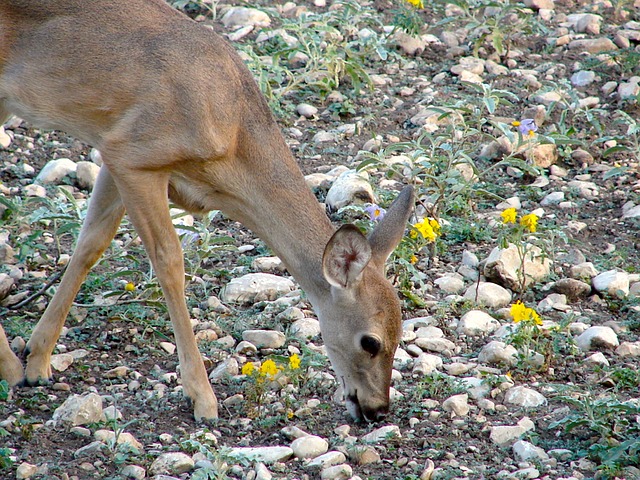
One interesting thing about the digestive system of white tailed deer is that at certain times of the year, the microbes inside their stomach change in significant ways. As a result, they tend to prefer fruit whenever possible at those times. Fiber and cellulose are always vital parts of the white-tailed deer’s diet.
Mushrooms and Grains Eaten by White Tailed Deer
Mushrooms are among the foods you will see white tailed deer gravitate towards. Deer will find mushrooms that are rich in phosphorus, and this is especially important for male deer that grow antlers.
White tailed deer will eat foods such oats, soybeans, rye, pecans, and wheat whenever they’re able to find them. These foods are useful for the animal because they are rich in carbohydrates, a specific kind of protein, and phosphorus.
White Tailed Deer Enjoy Nuts and Fruit
You’ll sometimes hear people in the know refer to the fruit and nuts white tailed deer eat as mast. This includes fruit that comes from trees and shrubs. Hickory nuts, acorns, and beechnuts are referred to as hard mast. Soft mast includes berries, drupes, rose hip, some flower buds, and wild fruits.
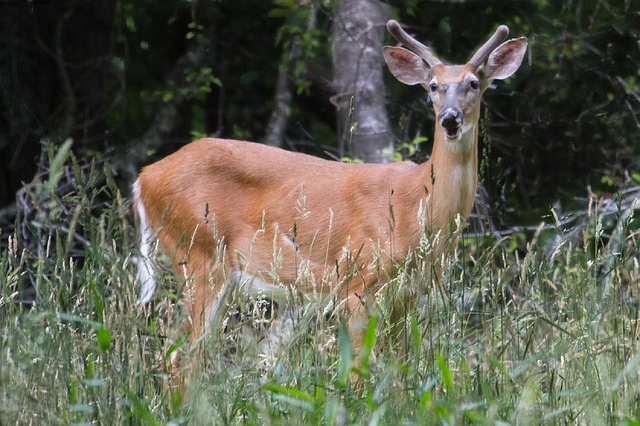
Deer like these foods because of the energy boost they provide. They are also good for antler growth and keeping the animal as warm as possible in cold weather.
What Types of Mast Do Deer Eat?
Let’s take a look at some of the specific kinds of mast that white tailed deer will eat:
- Acorns, hickory nuts, and chestnuts are important parts of the white tailed deer diet because of the carbohydrates, fats, protein, and tannins they provide. These foods help with their digestion (including proper absorption of nutrients).
- Mulberries, plums, blackberries, and grapes provide lots of carbohydrates, which supports rapid antler growth.
- Pears and apples provide a fantastic energy boost. These foods are also great for helping deer store as much energy as they can for the winter.
- Woody browse is a category of food that includes buds, leaves, and twigs. Many of these foods are bits that fall off the forest trees when they dry out. Significant rain or wind can also make such food fall to the forest floor.
- Some of the leaves and types of browse that are most common for white tailed deer to eat include white pine, yellow birch, elm, seek sumac, white cedar, oak, maple trees, hackberry, Greenbrier, and grape vines.
- Brassica blend is a name for mustard species of forage. This grows quite quickly and can appear in various parts of the forest. Sometimes it’s more common in cold weather.
- Vegetables such as cabbage, canola, turnip, kale, cauliflower, and radish sometimes also play a part in the diet of white tailed deer.
White Tailed Deer Diet Varies by Season
The typical diet of a white tailed deer varies by season. Deer know what types of food are available at different times of year, and their movements will reflect this knowledge as they seek out the best forage available to them.
Fall
Fall is the season in which deer really feast on their food. The reason why these animals have to eat as much as they possibly can at this time of year is the necessity of fattening up for the winter.
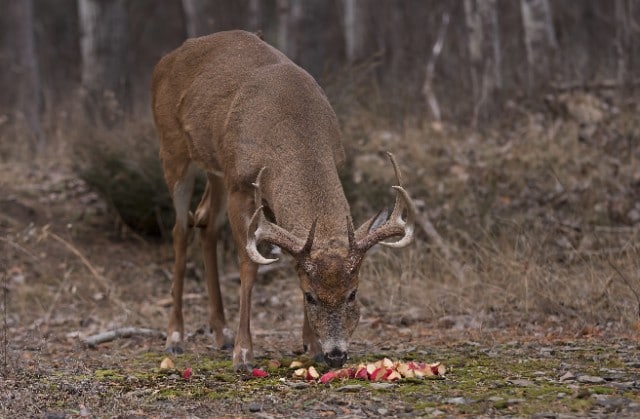
During the fall, deer are most likely to gravitate towards foods such as pears and apples as they’re rich in carbs and most orchards will have a bountiful supply of rotting fruit below their trees.
They will also seek out fatty nuts such as pecans and peanuts. White tailed deer will also try to eat a lot of mushrooms and fungi in the fall. These foods are rich in vitamins and carbohydrates.
Winter
One of the reasons why white tailed deer eat so much during the fall is because of the lack of food available during the winter season. Some foods you might see deer eating during the winter include acorns and hickory nuts, as well as woody plants.
White tailed deer browse for their food. They do not graze in the way that sheep or cows do. This is why deer aren’t compelled to find food hidden by the snow. They’re able to do this when required, though.
Spring
Deer find relief in the spring with a new abundance of food. In this season, deer will be especially attracted to foods rich in carbohydrates and phosphorus. Examples include mushrooms, fruits, and nuts.
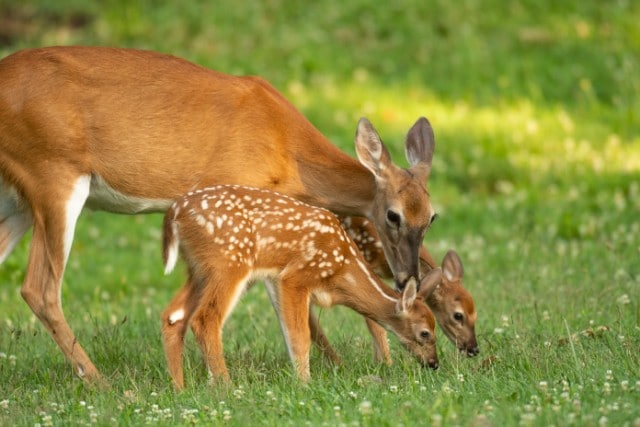
Deer will also eat young grass a great deal at this time of year. There are also many berries and shrubs that will attract white tailed deer.
Summer
White tailed deer tend to eat a great deal during the summer. They especially focus on fruits, grains, and nuts. Tree leaves and developing weeds are also important parts of their diet during the summer.
To deal with the hot weather and help prevent dehydration, deer will spend more time near fresh water sources during the summer as well. Be aware that there will probably be potentially dangerous predators by the water too, so if you’re in the forest looking for deer keep your eyes open.
How Does Their Digestive System Work?
Deer are ruminants, like cows. This means that their stomachs are comprised of four different chambers that are used in the process of food digestion. When a deer eats vegetation with high fat or sugar content (such as fungi, nuts, and fruits), digestion is easy.
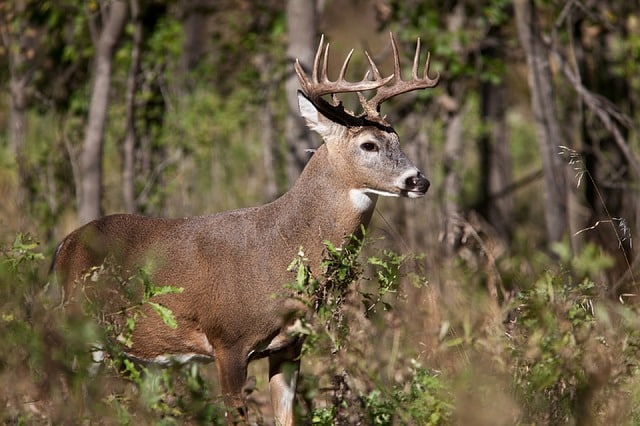
If vegetation contains cellulose, it takes quite a bit of time for the food to be digested by the enzymes in the white tailed deer’s stomach. The protozoa and bacteria in the deer’s digestive system are essential in fermenting the food and breaking it down in the necessary way.
The chambers of a deer’s stomach are:
- Rumen
- Reticulum
- Omasum
- Abomasum
Bile is mixed into the food in the first two chambers of the stomach (the rumen and reticulum). This is what creates cud.
Cud is what the animal regurgitates, chews, and then swallows again. Once this happens, it goes through the rumen. It then goes to the omasum, which is where water is extracted.
In the last step, food goes into the last chamber. This is called the abomasum. It is there that it is passed on to the small intestine and then the food’s nutrients can be absorbed by the body.
As we’ve learned here, there is a great deal to understand about the white tailed deer if you want to track and find it for any reason.
Now that you’ve answered the question “What does a white tailed deer eat?” you can seek out the areas of the forest with those food sources. With patience, the deer will come.

